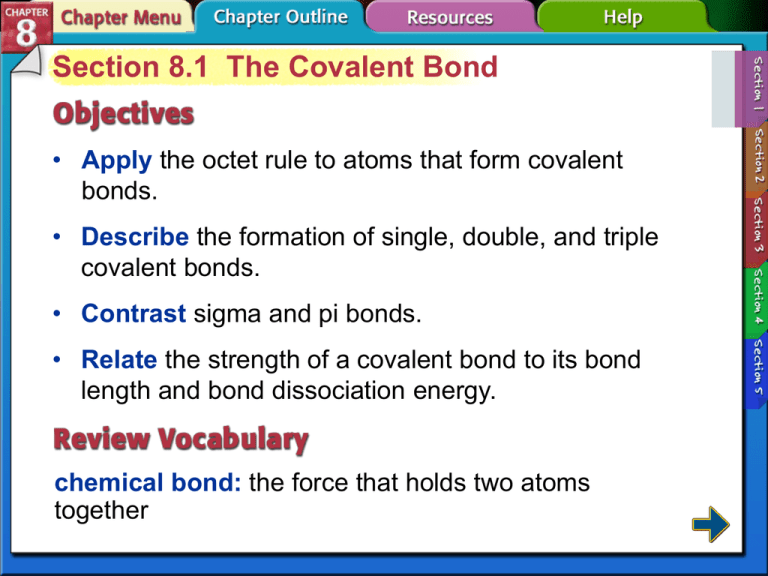covalent bond
advertisement

Section 8.1 The Covalent Bond • Apply the octet rule to atoms that form covalent bonds. • Describe the formation of single, double, and triple covalent bonds. • Contrast sigma and pi bonds. • Relate the strength of a covalent bond to its bond length and bond dissociation energy. chemical bond: the force that holds two atoms together Section 8.1 The Covalent Bond (cont.) covalent bond pi bond molecule endothermic reaction Lewis structure exothermic reaction sigma bond Atoms gain stability when they share electrons and form covalent bonds. Why do atoms bond? • Atoms gain stability when they share electrons and form covalent bonds. • Lower energy states make an atom more stable. • Gaining or losing electrons makes atoms more stable by forming ions with noble-gas electron configurations. • Sharing valence electrons with other atoms also results in noble-gas electron configurations. Why do atoms bond? (cont.) • Atoms in non-ionic compounds share electrons. • The chemical bond that results from sharing electrons is a covalent bond. • A molecule is formed when two or more atoms bond. Why do atoms bond? (cont.) • Diatomic molecules (H2, F2 for example) exist because two-atom molecules are more stable than single atoms. Why do atoms bond? (cont.) • The most stable arrangement of atoms exists at the point of maximum net attraction, where the atoms bond covalently and form a molecule. Single Covalent Bonds • When only one pair of electrons is shared, the result is a single covalent bond. • The figure shows two hydrogen atoms forming a hydrogen molecule with a single covalent bond, resulting in an electron configuration like helium. Single Covalent Bonds (cont.) • In a Lewis structure dots or a line are used to symbolize a single covalent bond. • The halogens—the group 17 elements—have 7 valence electrons and form single covalent bonds with atoms of other non-metals. Single Covalent Bonds (cont.) • Atoms in group 16 can share two electrons and form two covalent bonds. • Water is formed from one oxygen with two hydrogen atoms covalently bonded to it . Single Covalent Bonds (cont.) • Atoms in group 15 form three single covalent bonds, such as in ammonia. Single Covalent Bonds (cont.) • Atoms of group 14 elements form four single covalent bonds, such as in methane. Single Covalent Bonds (cont.) • Sigma bonds are single covalent bonds. • Sigma bonds occur when the pair of shared electrons is in an area centered between the two atoms. Multiple Covalent Bonds • Double bonds form when two pairs of electrons are shared between two atoms. • Triple bonds form when three pairs of electrons are shared between two atoms. Multiple Covalent Bonds (cont.) • A multiple covalent bond consists of one sigma bond and at least one pi bond. • The pi bond is formed when parallel orbitals overlap and share electrons. The Strength of Covalent Bonds • The strength depends on the distance between the two nuclei, or bond length. • As length increases, strength decreases. The Strength of Covalent Bonds (cont.) • The amount of energy required to break a bond is called the bond dissociation energy. • The shorter the bond length, the greater the energy required to break it. The Strength of Covalent Bonds (cont.) • An endothermic reaction is one where a greater amount of energy is required to break a bond in reactants than is released when the new bonds form in the products. • An exothermic reaction is one where more energy is released than is required to break the bonds in the initial reactants. Section 8.2 Naming Molecules • Translate molecular formulas into binary molecular compound names. oxyanion: a polyatomic ion in which an element (usually a nonmetal) is bonded to one or more oxygen atoms • Name acidic solutions. oxyacid Specific rules are used when naming binary molecular compounds, binary acids, and oxyacids. Naming Binary Molecular Compounds • The first element is always named first using the entire element name. • The second element is named using its root and adding the suffix –ide. Naming Binary Molecular Compounds (cont.) • Prefixes are used to indicate the number of atoms of each element in a compound. Naming Binary Molecular Compounds (cont.) • Many compounds were discovered and given common names long before the present naming system was developed (water, ammonia, hydrazine, nitric oxide). Name the following binary covalent compounds. 1. 2. 3. 4. 5. CO2 SO2 NF3 CCl4 What is the formula for diarsenic trioxide? Naming Acids • The first word has the prefix hydrofollowed by the root of the element plus the suffix –ic. • The second word is always acid (hydrochloric acid is HCl in water). Naming Acids (cont.) • An oxyacid is an acid that contains both a hydrogen atom and an oxyanion. • Identify the oxyanion present. • The first word is the root of the oxyanion and the prefix per- or hypo- if it is part of the name, plus the suffix -ic if the anion ends in -ate or -ous if the oxyanion ends in -ite. Naming Acids (cont.) • The second word is always acid. Name the following acids. 1. HI 2. HClO3 3. HClO2 4. H2SO4 5. H2S 6. What is the formula for periodic acid? Naming Acids (cont.) • An acid, whether a binary acid or an oxyacid, can have a common name in addition to its compound name. Naming Acids (cont.) • The name of a molecular compound reveals its composition and is important in communicating the nature of the compound. Naming Acids (cont.) Give the formula for each compound. 1. silver chloride 2. dihydrogen oxide 3. chlorine trifluoride 4. diphosphorus trioxide 5. strontium acetate 6. What is the formula for carbonic acid? Section 8.3 Molecular Structures • List the basic steps used to draw Lewis structures. • Explain why resonance occurs, and identify resonance structures. • Identify three exceptions to the octet rule, and name molecules in which these exceptions occur. ionic bond: the electrostatic force that holds oppositely charged particles together in an ionic compound Section 8.3 Molecular Structures (cont.) structural formula resonance coordinate covalent bond Structural formulas show the relative positions of atoms within a molecule. Structural Formulas • A structural formula uses letter symbols and bonds to show relative positions of atoms. Structural Formulas (cont.) • Drawing Lewis Structures – Predict the location of certain atoms. – Determine the number of electrons available for bonding. – Determine the number of bonding pairs. – Place the bonding pairs. – Determine the number of bonding pairs remaining. – Determine whether the central atom satisfies the octet rule. • 1. 2. 3. 4. 5. 6. Draw Lewis structures for the following molecules: BH3 NH3 silicon tetrahydride nitrogen trifluoride carbon dioxide selenium trioxide • Draw Lewis structures for the following molecules: 7. O2 8. C2H4 9. CS2 10. HCN • Draw Lewis structures for the following ions: 11. phosphate 12. ammonium 13. bromate 14. perchlorate 15. hydroxide Structural Formulas (cont.) • Atoms within a polyatomic ion are covalently bonded. Resonance Structures • Resonance is a condition that occurs when more than one valid Lewis structure can be written for a molecule or ion. • This figure shows three correct ways to draw the structure for (NO3)1. Resonance Structures (cont.) • Two or more correct Lewis structures that represent a single ion or molecule are resonance structures. • The molecule behaves as though it has only one structure. • The bond lengths are identical to each other and intermediate between single and double covalent bonds. Exceptions to the Octet Rule • Some molecules do not obey the octet rule. • A small group of molecules might have an odd number of valence electrons. • NO2 has five valence electrons from nitrogen and 12 from oxygen and cannot form an exact number of electron pairs. Exceptions to the Octet Rule (cont.) • A few compounds form stable configurations with less than 8 electrons around the atom—a suboctet. • A coordinate covalent bond forms when one atom donates both of the electrons to be shared with an atom or ion that needs two electrons. Exceptions to the Octet Rule (cont.) • A third group of compounds has central atoms with more than eight valence electrons, called an expanded octet. • Elements in period 3 or higher have a d-orbital and can form more than four covalent bonds. Section 8.5 Electronegativity and Polarity • Describe how electronegativity is used to determine bond type. • Compare and contrast polar and nonpolar covalent bonds and polar and nonpolar molecules. • Generalize about the characteristics of covalently bonded compounds. electronegativity: the relative ability of an atom to attract electrons in a chemical bond Section 8.5 Electronegativity and Polarity (cont.) polar covalent bond A chemical bond’s character is related to each atom’s attraction for the electrons in the bond. Electron Affinity, Electronegativity, and Bond Character • Electron affinity measures the tendency of an atom to accept an electron. • Noble gases are not listed because they generally do not form compounds. • Solubility is the property of a substance’s ability to dissolve in another substance. • Polar molecules and ionic substances are usually soluble in polar substances. • Non-polar molecules dissolve only in non-polar substances. Properties of Covalent Compounds • Covalent bonds between atoms are strong, but attraction forces between molecules are weak. • The weak attraction forces are known as van der Waals forces. • The forces vary in strength but are weaker than the bonds in a molecule or ions in an ionic compound. Properties of Covalent Compounds (cont.) • Non-polar molecules exhibit a weak dispersion force, or induced dipole. • The force between two oppositely charged ends of two polar molecules is a dipole-dipole force. • A hydrogen bond is an especially strong dipole-dipole force between a hydrogen end of one dipole and a fluorine, oxygen, or nitrogen atom on another dipole. Properties of Covalent Compounds (cont.) • Many physical properties are due to intermolecular forces. • Weak forces result in the relatively low melting and boiling points of molecular substances. • Many covalent molecules are relatively soft solids. • Molecules can align in a crystal lattice, similar to ionic solids but with less attraction between particles. Properties of Covalent Compounds (cont.) • Solids composed of only atoms interconnected by a network of covalent bonds are called covalent network solids. • Quartz and diamonds are two common examples of network solids.




